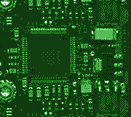The motherboard
is the centre piece of you system it contains all the circuitry and components either directly on the board or via additional
components which connect directly to it. The motherboard is also often referred to as the main board.
The motherboards
many connectors and slots include a socket for the processor to be installed along with memory slots, a number of expansion
slots, connectors to IDE/SATA devices and smaller connectors for USB, serial and printer connectors.
The motherboard
plays an essential role in the following aspects of your computer system:
Organization
of devices: Everything is eventually connected to the motherboard. The way that the motherboard is designed and laid out dictates
how the entire computer is going to be organized.
Control of
the devices: Built-in to the motherboard is the chipset and BIOS program, which between them control the majority of data
flow throughout the different computer systems.
System Communication:
Almost all communication between the PC and its peripherals, other PCs, and you, the user, goes through the motherboard.
Processor Support:
The motherboard socket depicts which choice of processor you can use in your system.
Peripheral
Support: The motherboards components determine what type of peripherals you can use in your PC. For example, you can not use
AGP cards if you only have PCI slots.
System Performance:
The motherboard is a major factor in your system's performance; it dictates which type of processors, memory, system buses,
and hard disk interface speed your system can have via its connectors or BIOS settings. Often if you are upgrading after a
number of years you will need to replace the board, CPU, and memory.
Upgradeability:
As motherboards are developed newer processors may not be compatible with your hardware as limitations of the circuitry built-in
to the board itself will not allow them to run. As a result you can look for any upgrades via your maker's website but may
need to consider upgrading.




